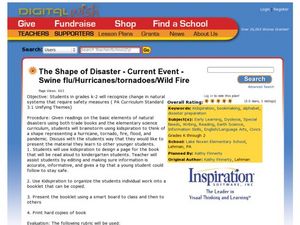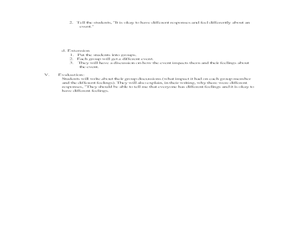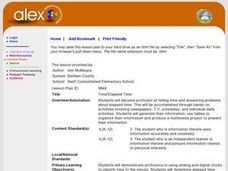Curated OER
Weather Emergency Safety
Learners identify different types of weather emergencies that may happen during the seasons. They list the steps involved when taking cover and fleeing dangerous weather patters. A comprehensive list of service agencies that can...
Curated OER
Dangerous Storms
Young scholars examine media language for dangerous storms stressing; preparation, evacuation, and emergency assistance, and problem-solving techniques for emergency situations.
Curated OER
Phenomenal Weather-Related Statistics
Eighth graders research, collect and interpret data about weather statistics. They record that data on spreadsheets. they create Powerpoint presentations on their individual or group research.
Curated OER
Storms - What am I?
In this earth science worksheet, students use the clues to determine each of the stormy words in the puzzle. There are nine clues listed on the sheet.
Curated OER
What's In The Wind?
In this what's in the wind worksheet, learners, with a partner, complete four activities involving different types of wind, different types of phrases involving wind and conversation questions regarding homeland weather conditions.
Curated OER
The Weather
Fourth graders investigate how weather conditions and phenomena occur and how they can be predicted. They complete an internet search. Students create a weather fact sheet over a selected weather phenomenon.
Curated OER
World's Most Dynamic Force
Students explore the Earth's forces. They review an assessment task and its accompanying rubric. They classify ten items as long-term or short-term interactions of the Earth's components and rank the destructive impact of the forces. ...
Curated OER
The Shape of Disaster - Current Event- Swine Flu/Hurricanes/Tornadoes/Wild Fire
Students create a disaster preparation book. In this disaster preparation lesson, students research disasters and use the kidspiration program to create a shape to represent each disaster. They create a page for each disaster.
Curated OER
Storm Watch: Knowing What To Do
Students study the different types of weather and how storms form. In this weather lesson students make their own "tornado in a bottle" and create brochures.
Alabama Learning Exchange
Are You Prepared?
Pupils research specific natural disasters using the Internet and a collection of books. The natural disasters include; floods, hurricanes, tornadoes, tsunamis, winter stroms, wildfires, thunderstorms, volcanoes, and earthquakes. They...
Curated OER
Forces of Nature Vocabulary Quiz
In this science worksheet, students draw lines to match 13 words pertaining to forces of nature to their definitions in another column. Example: tornado, tide, erosion, pressure.
EngageNY
Building Background Knowledge and Making Inferences: What Is a Natural Disaster?
That's a disaster! Scholars complete a gallery walk to view images and make inferences about natural disasters. They fill out a note catcher about what they observe and infer any questions they may have. They then participate in a World...
Curated OER
Learning About Weather
Students decide what type of weather they would like to write about such as tornadoes, hurricanes, snow, hail, floods, or another type of weather.
Then, they look up the information and jot down notes about that particular subject....
Curated OER
Wild Weather Vocabulary Dice
In this wild weather vocabulary dice worksheet, students assemble a dice that uses the words: tropical, hurricane, tornado, monsoon and tornado. A reference web site for additional activities is given.
Curated OER
Feelings about Current Events
Students explore feelings about negative events. In this health and social studies lesson, students discuss and write about personal feelings about events that have had an impact on their life, such as hurricanes, tornadoes, and plane...
Curated OER
Weather Word Search
In this weather words worksheet, students analyze 10 words in a word box that pertain to the weather. Students find these words in a word search puzzle.
NASA
Erosion and Landslides
A professional-quality PowerPoint, which includes links to footage of actual landslides in action, opens this moving lesson. Viewers learn what conditions lead to erosion and land giving way. They simulate landslides with a variety of...
American Museum of Natural History
Make Your Own Weather Station
Scholars build a weather station equipped with a wind vane, rain gauge, and barometer. Following an informative page about the weather, learners follow steps to build their pieces then turn into meteorologists to chart the weather they...
Curated OER
Wiki Comment: The News and You
Kids explore the world of news media by creating a wiki page. They will create a wiki page on the Internet in order to comment on and question the stories that take place in the world. They will practice creative writing by summarizing...
Curated OER
Multiplying With Nine As A Factor
Elementary math minds complete various activities to memorize the multiples of nine. They watch a PowerPoint presentation and demonstrate the finger trick. Unfortunately the link to the multiplication activities does not take you...
Curated OER
Time/Elapsed Time
Young mathematicians complete various activities to demonstrate proficiency in telling time and identifying elapsed time. They analyze and discuss television schedules, create a booklet about their daily activities, produce a TV. guide,...
Curated OER
Water Cycle - A SiteMaker Presentation
Have your young scientists explore a single element of the water cycle and write a report to explain findings. Your class can take their writing through all the steps of the writing process and publish it using a Web-based multimedia...
Curated OER
Swamps, Shrimp, and Tsunamis: A Simulation of Sustainable Development Issues in Coastal Ecuador
Learners examine the economic benefits, environmental losses and dangers of the shrimp farming industry on the coast of Ecuador. They read a script, role-play people involved in the shrimp business, and write an essay of the pros and cons.
Curated OER
Volcanoes and People
Students discover that volcanic eruptions are geologic events that take place within the upper part and on the surface of the Earth's lithosphere. They explain how volcanoes are related to the Earth's lithosphere. They focus on the May...

























